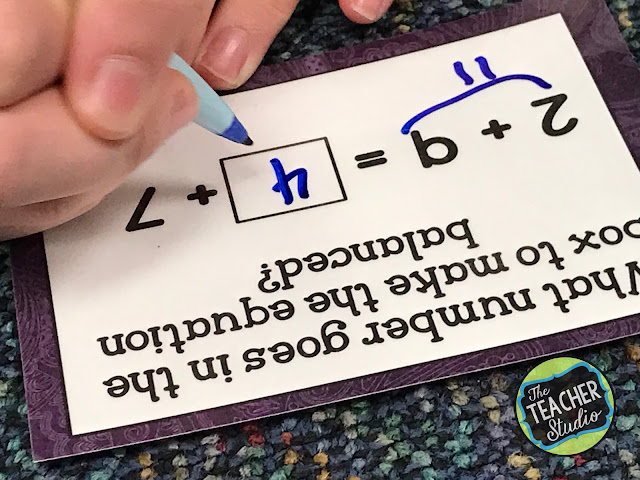Today's "Teacher Tip" involves laminating--and I know many of you probably DO laminate your cards to keep them safe and sound for repeated use. Do you also laminate them so that students can INTERACT with them? I do!
This is especially powerful when you are working with students on math concepts. Sure, they can recopy the problems into their math notebooks--but how about using the cards to show their work? The photo below was taken during an intervention group I was doing with a few students who were really struggling with basic equations and the concept of "equal". By having them write directly on the card as they talked through their thinking, I could correct misconceptions and see what they were doing incorrectly so I could coach.
Not using them for interventions? Have students write on their cards and switch with a partner to check. Want to REALLY get them thinking? Ask students to do several cards--and to make one mistake for their partner to find!
Another example of how powerful it can be to have students write directly on their task cards is when you are doing anything spatial like geometry, measurement, or patterning. This past week we wrapped up our area and perimeter unit and I wanted the students to work in pairs to do some practice work--and these task cards were perfectly suited for interactive work! Students carved out rectangles out of the irregular shapes, labeled sides, and found solutions together. It was fascinating to hear the great math talk as they made their decisions about how to divide their shapes.
As they worked, I walked around and coached--and was able to give some instructional hints like, "Do you think it would help to label the sides first?" Mistakes were easily wiped away!
So whether you use task cards in stations, as review tools, for enrichment, or as warm ups--consider whether having students write directly on the cards might be a great way to see their thinking and help clear up any misconceptions.
Another great advantage to this technique is that you can easily slip a task card under a document camera to share student thinking or solutions! Students can point to the screen and share what they did--and why they did it! Teachers can ALSO write on task cards under the document camera to show strategies, remind students about labels, highlight directions, share hints, and so on. In fact, I'll often save a card that shows a solution to refer to later--I can remember a card that showed a great solution to a patterning problem that I knew would help us with a later lesson. I saved the card and showed it a few days later to help hammer home the minilesson.
Task cards are great for so many reasons--just a little reminder that we can really make them a tool to deliver instruction and for students to represent their learning. If you are interested in any of the resources pictured, just click the image to see more!
Want to pin this post for later? Here you go!
Follow me on...
Instagram @Fourthgradestudio
Twitter @FourthGrStudio







